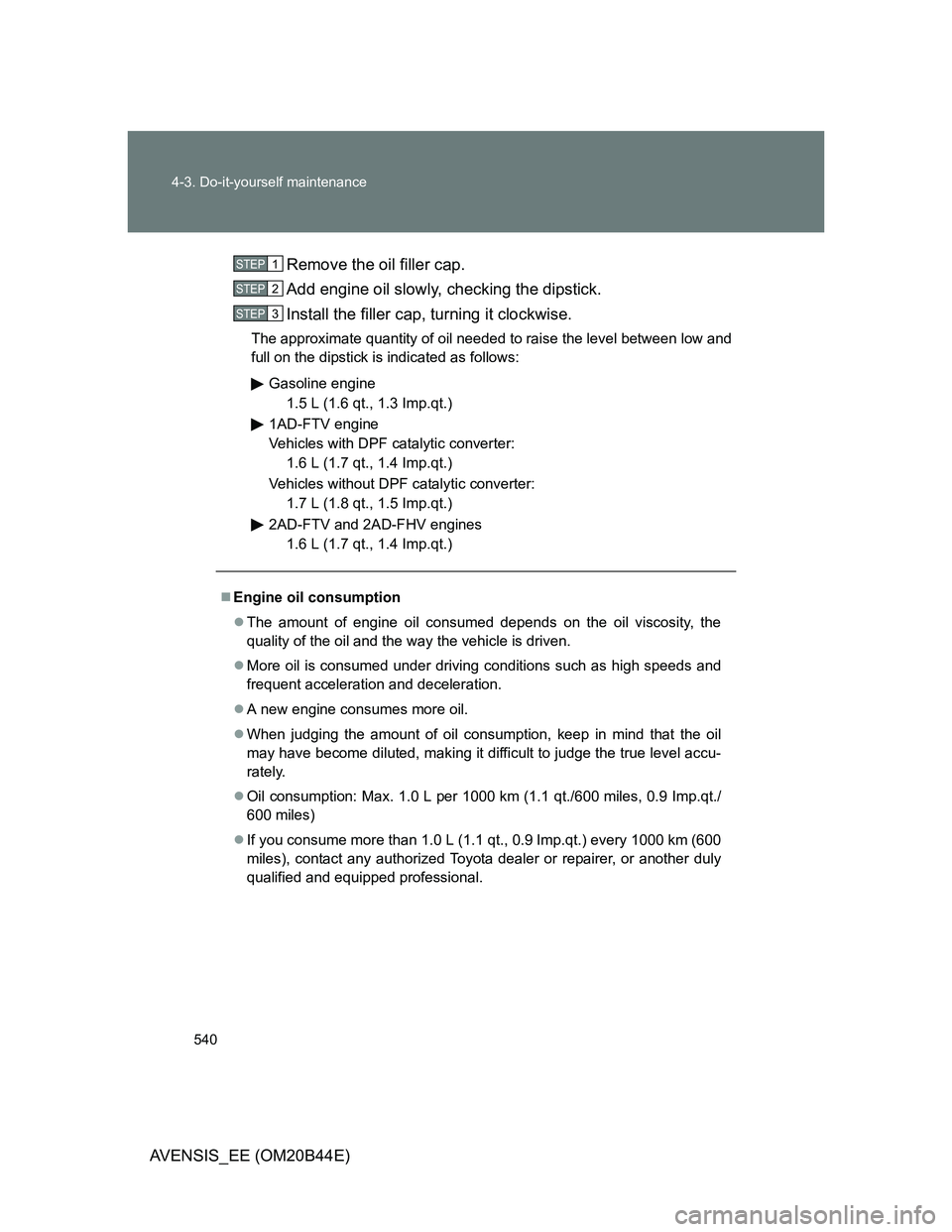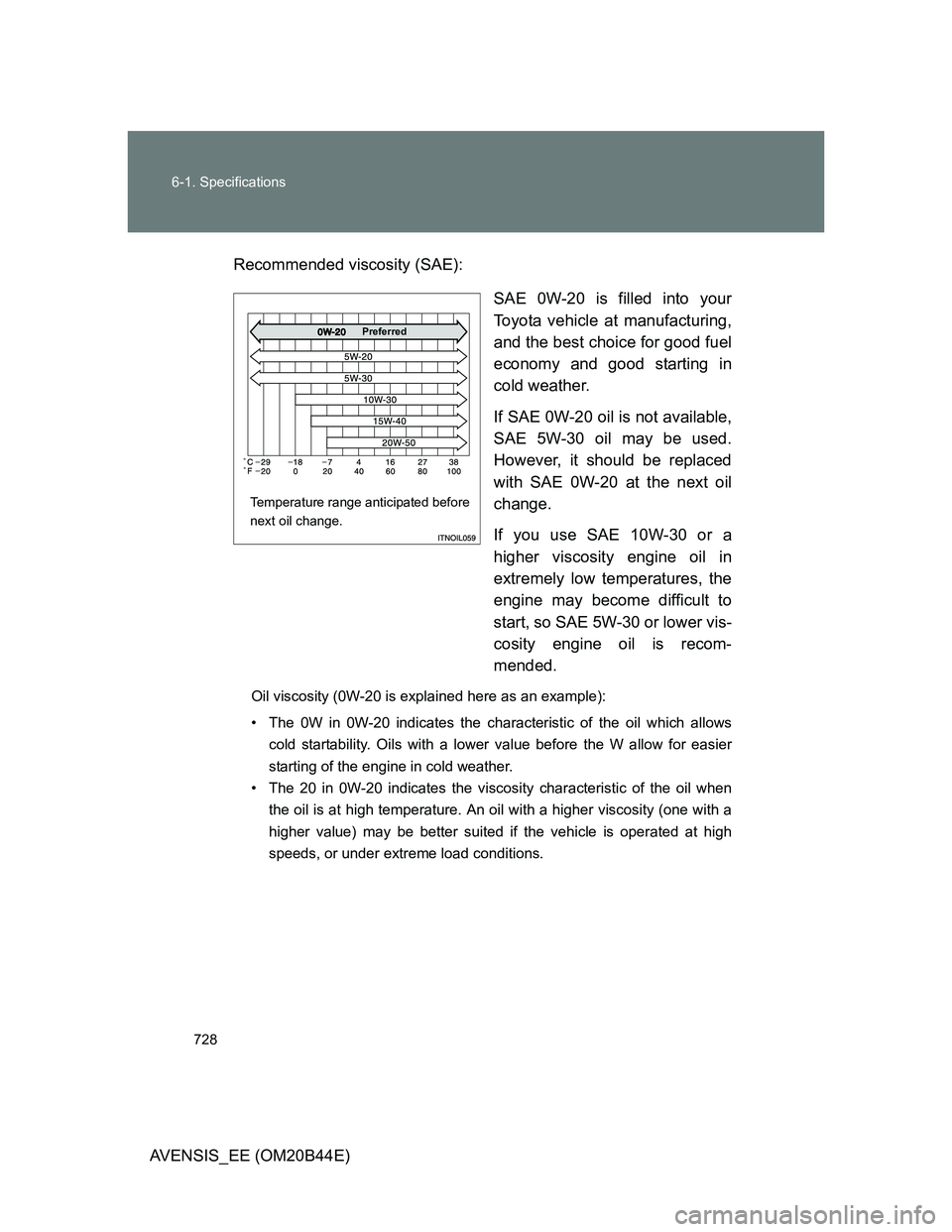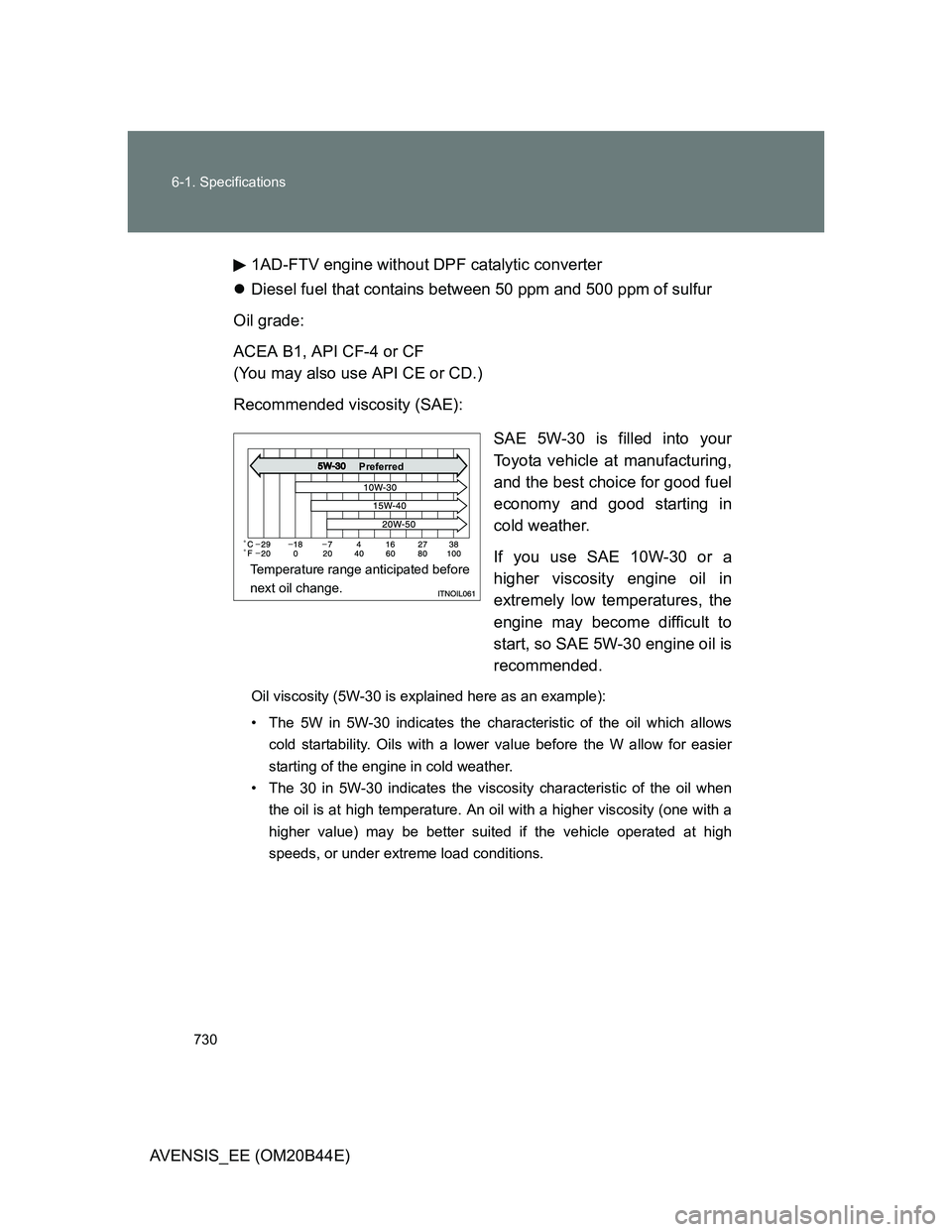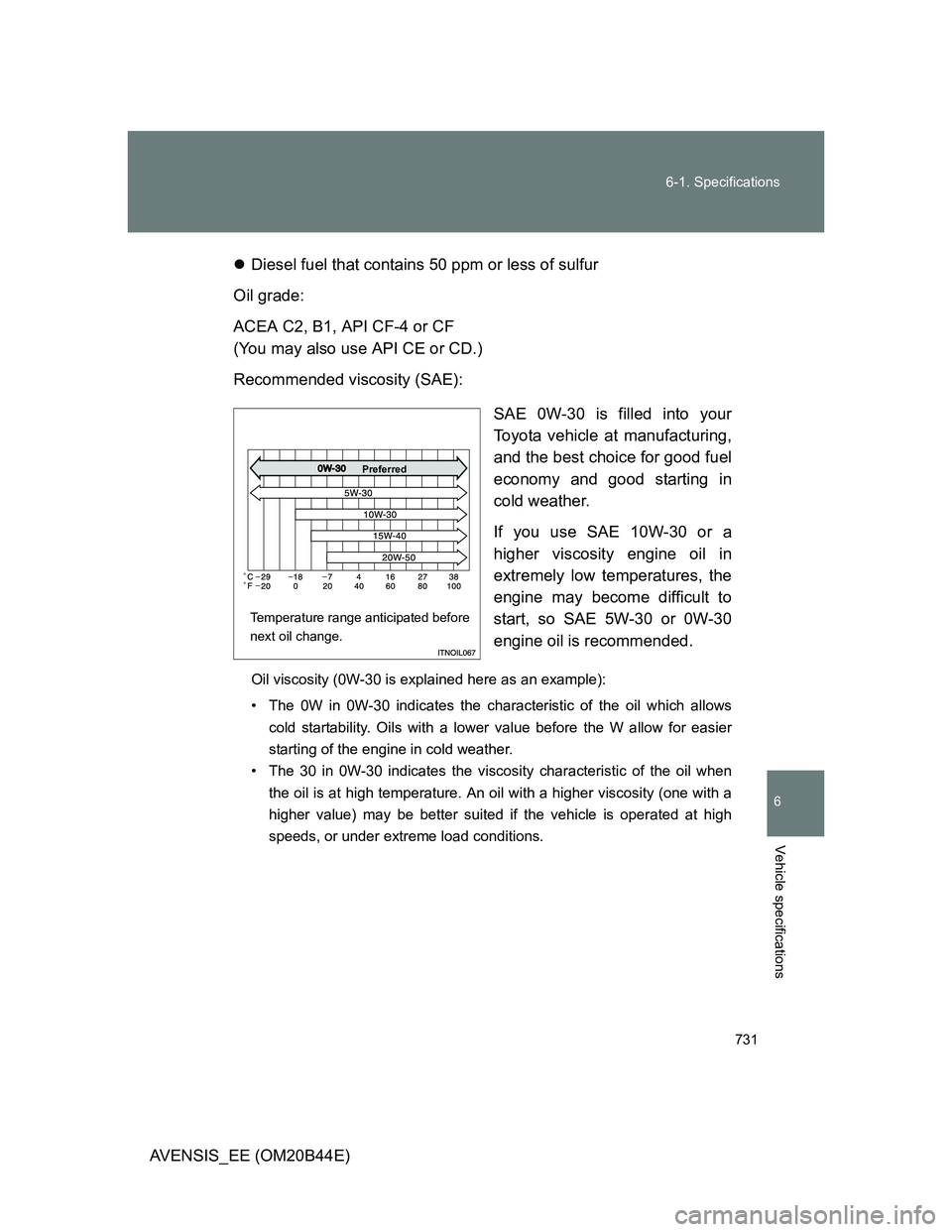Page 540 of 772

540 4-3. Do-it-yourself maintenance
AVENSIS_EE (OM20B44E)Remove the oil filler cap.
Add engine oil slowly, checking the dipstick.
Install the filler cap, turning it clockwise.
The approximate quantity of oil needed to raise the level between low and
full on the dipstick is indicated as follows:
Gasoline engine
1.5 L (1.6 qt., 1.3 Imp.qt.)
1AD-FTV engine
Vehicles with DPF catalytic converter:
1.6 L (1.7 qt., 1.4 Imp.qt.)
Vehicles without DPF catalytic converter:
1.7 L (1.8 qt., 1.5 Imp.qt.)
2AD-FTV and 2AD-FHV engines
1.6 L (1.7 qt., 1.4 Imp.qt.)
Engine oil consumption
The amount of engine oil consumed depends on the oil viscosity, the
quality of the oil and the way the vehicle is driven.
More oil is consumed under driving conditions such as high speeds and
frequent acceleration and deceleration.
A new engine consumes more oil.
When judging the amount of oil consumption, keep in mind that the oil
may have become diluted, making it difficult to judge the true level accu-
rately.
Oil consumption: Max. 1.0 L per 1000 km (1.1 qt./600 miles, 0.9 Imp.qt./
600 miles)
If you consume more than 1.0 L (1.1 qt., 0.9 Imp.qt.) every 1000 km (600
miles), contact any authorized Toyota dealer or repairer, or another duly
qualified and equipped professional.
STEP1
STEP2
STEP3
Page 728 of 772

728 6-1. Specifications
AVENSIS_EE (OM20B44E)Recommended viscosity (SAE):
SAE 0W-20 is filled into your
Toyota vehicle at manufacturing,
and the best choice for good fuel
economy and good starting in
cold weather.
If SAE 0W-20 oil is not available,
SAE 5W-30 oil may be used.
However, it should be replaced
with SAE 0W-20 at the next oil
change.
If you use SAE 10W-30 or a
higher viscosity engine oil in
extremely low temperatures, the
engine may become difficult to
start, so SAE 5W-30 or lower vis-
cosity engine oil is recom-
mended.
Oil viscosity (0W-20 is explained here as an example):
• The 0W in 0W-20 indicates the characteristic of the oil which allows
cold startability. Oils with a lower value before the W allow for easier
starting of the engine in cold weather.
• The 20 in 0W-20 indicates the viscosity characteristic of the oil when
the oil is at high temperature. An oil with a higher viscosity (one with a
higher value) may be better suited if the vehicle is operated at high
speeds, or under extreme load conditions.
Temperature range anticipated before
next oil change.
Preferred
Page 729 of 772
729 6-1. Specifications
6
Vehicle specifications
AVENSIS_EE (OM20B44E)How to read oil container labels:
Either or both API registered marks are added to some oil containers
to help you select the oil you should use.
API Service Symbol
Top portion: The oil quality desig-
nation by API (American Petro-
leum Institute) (SN)
Center portion: The SAE viscosity
grade (SAE 0W-20)
Lower portion: “Resource-Con-
serving” means that the oil has
fuel saving and environmental
protection.
ILSAC Certification Mark
The ILSAC (International Lubri-
cant Standardization and
Approval Committee) Certification
Mark is displayed on the front of
the container.
Page 730 of 772

730 6-1. Specifications
AVENSIS_EE (OM20B44E)1AD-FTV engine without DPF catalytic converter
Diesel fuel that contains between 50 ppm and 500 ppm of sulfur
Oil grade:
ACEA B1, API CF-4 or CF
(You may also use API CE or CD.)
Recommended viscosity (SAE):
SAE 5W-30 is filled into your
Toyota vehicle at manufacturing,
and the best choice for good fuel
economy and good starting in
cold weather.
If you use SAE 10W-30 or a
higher viscosity engine oil in
extremely low temperatures, the
engine may become difficult to
start, so SAE 5W-30 engine oil is
recommended.
Oil viscosity (5W-30 is explained here as an example):
• The 5W in 5W-30 indicates the characteristic of the oil which allows
cold startability. Oils with a lower value before the W allow for easier
starting of the engine in cold weather.
• The 30 in 5W-30 indicates the viscosity characteristic of the oil when
the oil is at high temperature. An oil with a higher viscosity (one with a
higher value) may be better suited if the vehicle operated at high
speeds, or under extreme load conditions.
Temperature range anticipated before
next oil change.
Preferred
Page 731 of 772

731 6-1. Specifications
6
Vehicle specifications
AVENSIS_EE (OM20B44E)Diesel fuel that contains 50 ppm or less of sulfur
Oil grade:
ACEA C2, B1, API CF-4 or CF
(You may also use API CE or CD.)
Recommended viscosity (SAE):
SAE 0W-30 is filled into your
Toyota vehicle at manufacturing,
and the best choice for good fuel
economy and good starting in
cold weather.
If you use SAE 10W-30 or a
higher viscosity engine oil in
extremely low temperatures, the
engine may become difficult to
start, so SAE 5W-30 or 0W-30
engine oil is recommended.
Oil viscosity (0W-30 is explained here as an example):
• The 0W in 0W-30 indicates the characteristic of the oil which allows
cold startability. Oils with a lower value before the W allow for easier
starting of the engine in cold weather.
• The 30 in 0W-30 indicates the viscosity characteristic of the oil when
the oil is at high temperature. An oil with a higher viscosity (one with a
higher value) may be better suited if the vehicle is operated at high
speeds, or under extreme load conditions.
Temperature range anticipated before
next oil change.
Preferred
Page 732 of 772
732 6-1. Specifications
AVENSIS_EE (OM20B44E)1AD-FTV engine with DPF catalytic converter, 2AD-FTV and 2AD-
FHV engines
Oil grade: ACEA C2
Recommended viscosity (SAE):
SAE 0W-30 is filled into your
Toyota vehicle at manufacturing,
and the best choice for good fuel
economy and good starting in
cold weather.
Oil viscosity (0W-30 is explained here as an example):
• The 0W in 0W-30 indicates the characteristic of the oil which allows
cold startability. Oils with a lower value before the W allow for easier
starting of the engine in cold weather.
• The 30 in 0W-30 indicates the viscosity characteristic of the oil when
the oil is at high temperature. An oil with a higher viscosity (one with a
higher value) may be better suited if the vehicle is operated at high
speeds, or under extreme load conditions.
NOTICE
Using engine oil other than ACEA C2 may damage the catalytic converter.
Temperature range anticipated before
next oil change.
Preferred